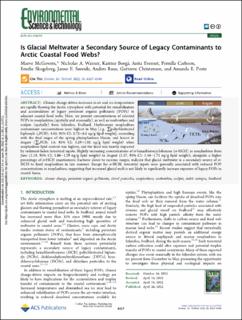| dc.contributor.author | Mcgovern, Maeve | |
| dc.contributor.author | Warner, Nicholas Alexander | |
| dc.contributor.author | Borgå, Katrine | |
| dc.contributor.author | Evenset, Anita | |
| dc.contributor.author | Carlsson, Pernilla Marianne | |
| dc.contributor.author | Skogsberg, Stina Linnea Emelie | |
| dc.contributor.author | Søreide, Janne | |
| dc.contributor.author | Ruus, Anders | |
| dc.contributor.author | Christensen, Guttorm | |
| dc.contributor.author | Poste, Amanda | |
| dc.date.accessioned | 2022-07-12T11:41:21Z | |
| dc.date.available | 2022-07-12T11:41:21Z | |
| dc.date.created | 2022-05-10T20:38:09Z | |
| dc.date.issued | 2022 | |
| dc.identifier.citation | Environmental Science and Technology. 2022, 56 (10), 6337-6348. | en_US |
| dc.identifier.issn | 0013-936X | |
| dc.identifier.uri | https://hdl.handle.net/11250/3004672 | |
| dc.description.abstract | Climate change-driven increases in air and sea temperatures are rapidly thawing the Arctic cryosphere with potential for remobilization and accumulation of legacy persistent organic pollutants (POPs) in adjacent coastal food webs. Here, we present concentrations of selected POPs in zooplankton (spatially and seasonally), as well as zoobenthos and sculpin (spatially) from Isfjorden, Svalbard. Herbivorous zooplankton contaminant concentrations were highest in May [e.g., ∑polychlorinated biphenyls (8PCB); 4.43, 95% CI: 2.72–6.3 ng/g lipid weight], coinciding with the final stages of the spring phytoplankton bloom, and lowest in August (∑8PCB; 1.6, 95% CI: 1.29–1.92 ng/g lipid weight) when zooplankton lipid content was highest, and the fjord was heavily impacted by sediment-laden terrestrial inputs. Slightly increasing concentrations of α-hexachlorocyclohexane (α-HCH) in zooplankton from June (1.18, 95% CI: 1.06–1.29 ng/g lipid weight) to August (1.57, 95% CI: 1.44–1.71 ng/g lipid weight), alongside a higher percentage of α-HCH enantiomeric fractions closer to racemic ranges, indicate that glacial meltwater is a secondary source of α-HCH to fjord zooplankton in late summer. Except for α-HCH, terrestrial inputs were generally associated with reduced POP concentrations in zooplankton, suggesting that increased glacial melt is not likely to significantly increase exposure of legacy POPs in coastal fauna. | en_US |
| dc.language.iso | eng | en_US |
| dc.publisher | American Chemical Society | en_US |
| dc.rights | Navngivelse 4.0 Internasjonal | * |
| dc.rights.uri | http://creativecommons.org/licenses/by/4.0/deed.no | * |
| dc.title | Is Glacial Meltwater a Secondary Source of Legacy Contaminants to Arctic Coastal Food Webs? | en_US |
| dc.type | Peer reviewed | en_US |
| dc.type | Journal article | en_US |
| dc.description.version | publishedVersion | en_US |
| dc.rights.holder | © 2022 The Authors | en_US |
| dc.source.pagenumber | 6337-6348 | en_US |
| dc.source.volume | 56 | en_US |
| dc.source.journal | Environmental Science and Technology | en_US |
| dc.source.issue | 10 | en_US |
| dc.identifier.doi | 10.1021/acs.est.1c07062 | |
| dc.identifier.cristin | 2023247 | |
| dc.relation.project | Norges forskningsråd: 268458 | en_US |
| cristin.ispublished | true | |
| cristin.fulltext | original | |
| cristin.qualitycode | 2 | |

